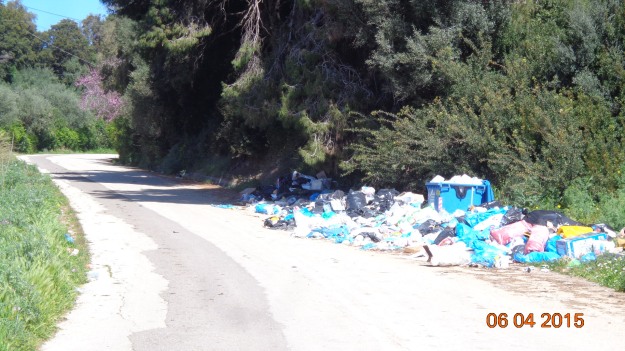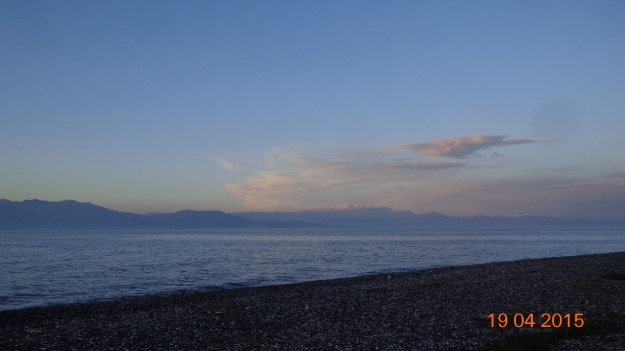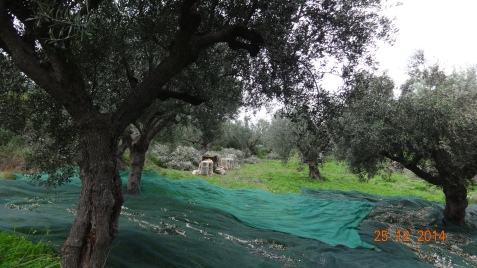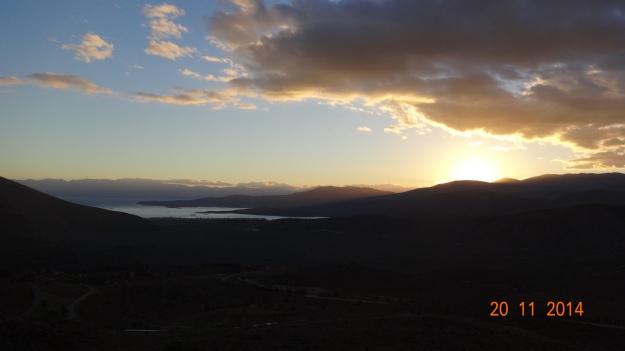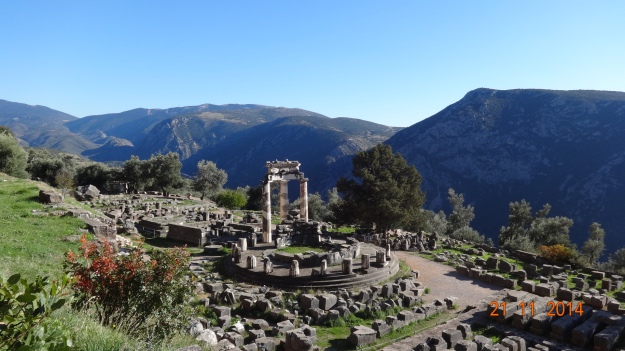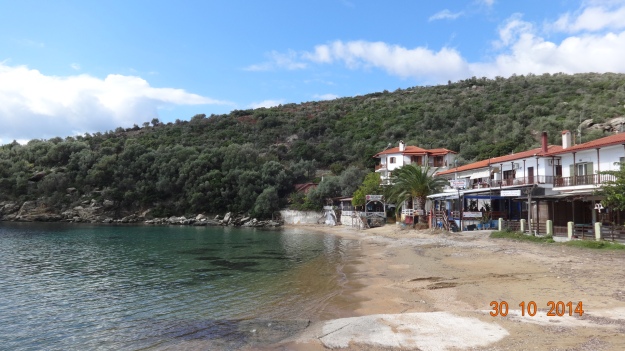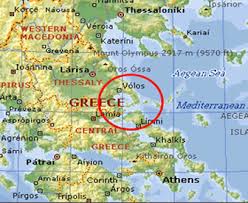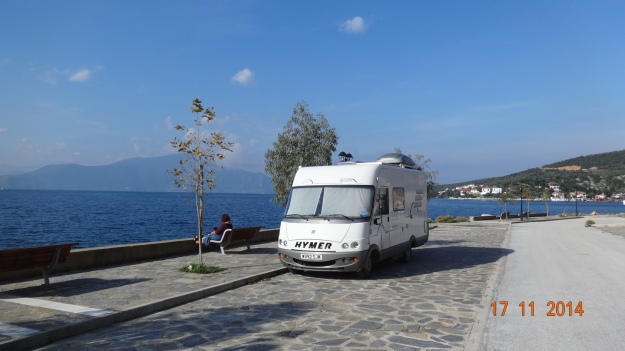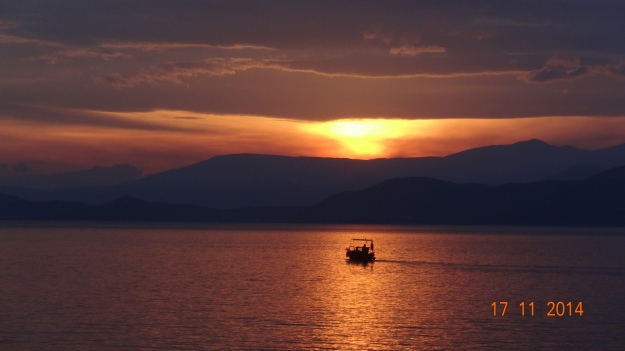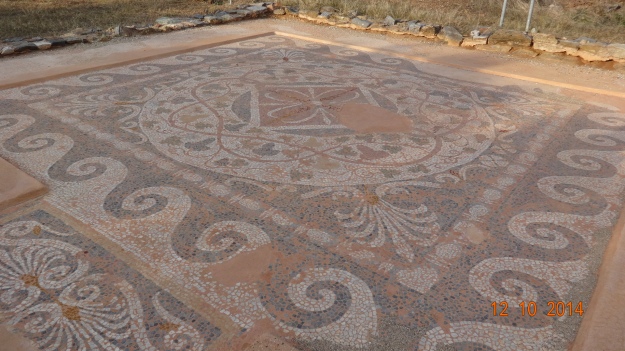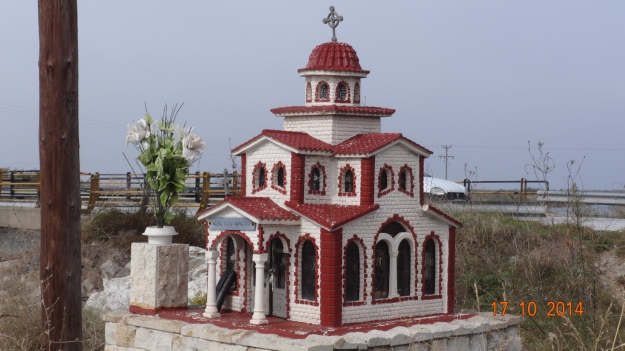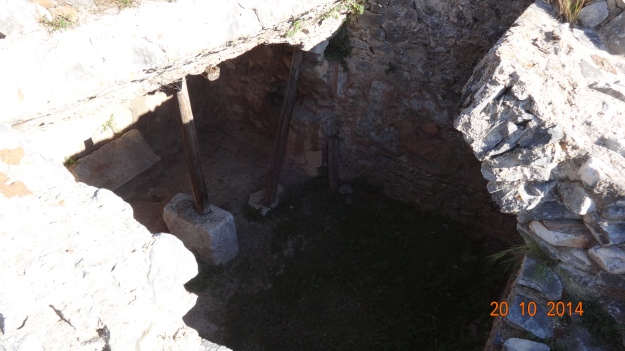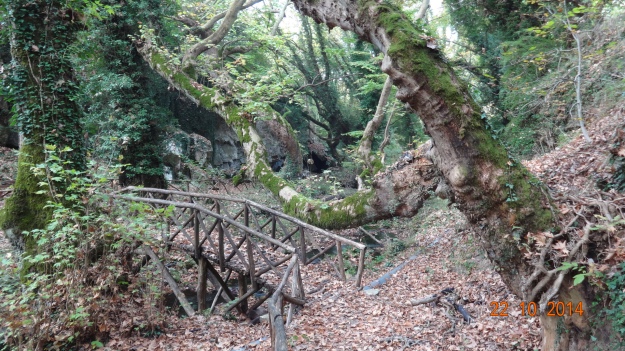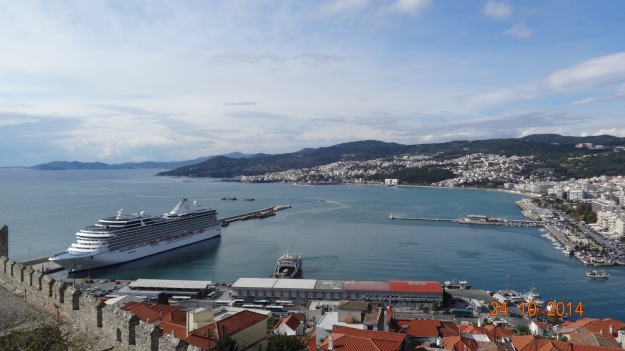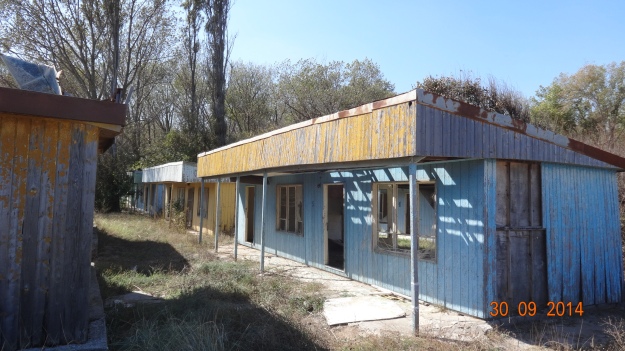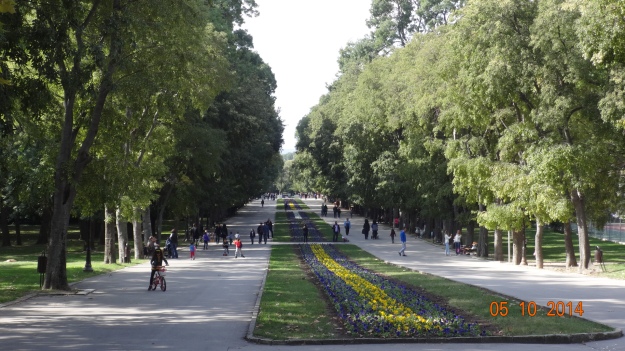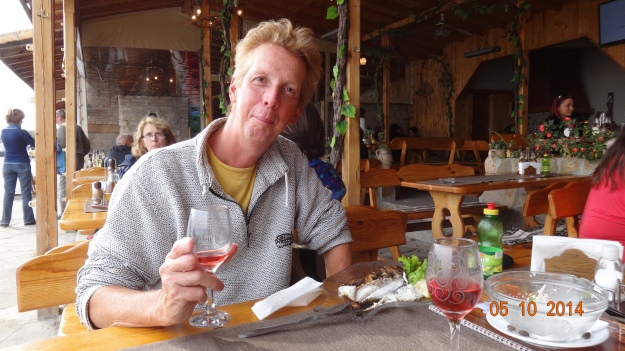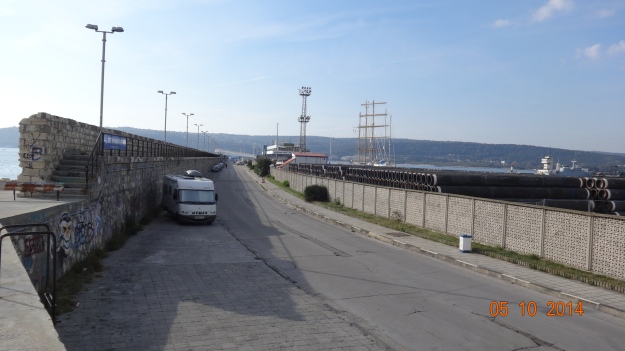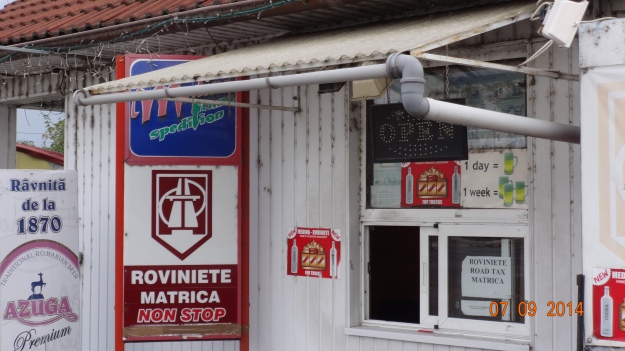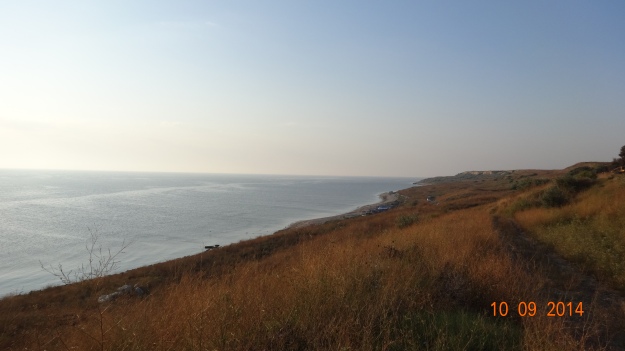Been playing with the formatting again – you can scroll over the sets of photos to see captions and if you click on them you’ll be able to see them full size.
This slideshow requires JavaScript.
The Argolis Peninsula / ‘Prefecture of Argolida’ – the Eastern-most finger (some call it the ‘thumb’) of the Peloponnese; just to the west of Athens.
We’ve spent over a month now, slowly exploring this area:  Weather
Weather

Is the sky supposed to be that colour?
If you think we’re lounging around on beaches in the sunshine, you’d be very wrong! We’re finding Greece, in winter, to be predominantly cold and wet. This last month, we’ve had temperatures down to –1 or –2 degrees C at night and plenty of grey days with temperatures struggling to get above 10 degrees. We had one day when 3 was the max. We’ve even had flurries of snow! Although it’s not settling at lower levels, there’s plenty on the mountains – pretty to look at, but making many of the mountain passes decidedly dicey in a front wheel drive van with rather too much weight on her rear end! When the sun does shine at these latitudes, we realise why we are down here. The temperature rapidly climbs to the mid teens and it feels a lot hotter in a sheltered spot. The change always comes as a bit of a shock. We definitely had the best of the weather whilst Clare was visiting; we even managed a swim once (it was flippin’ freezing!), and sat outside enjoying the sunshine on several occasions – I don’t think we’ve done that more than once in the past 3 weeks. Humph.

Stormy day at Nafplio harbour. Fences blown over. Difficult to stand!

Greece in winter!

The view today!
The Natural Beauty – beaches, volcanoes, caves
Beaches and Coastline:
There’s miles and miles of beautiful and varied coastline here. A lot of it is rather inaccessible, covered in sparse scrub and pine forest with steep slopes dropping straight into the sea, limited roads and very few paths. There are fewer beaches than you might expect and several of them, especially in the south, have been fenced off as part of private, gated, hotels and resorts – humph! Why is this ‘allowed’? – or perhaps it’s not, we’ve come across several abandoned examples in this small area. Some, perhaps all, we’ve discovered have been illegally constructed in designated ‘natural beauty’ areas. Rumours are that much of the construction is dodgy and concrete rot is also common. Perhaps they are just out-dated and not what people want these days? There doesn’t seem to be any let up with individual ‘villa’ developments.

Apollo Beach Resort. NW from Portocheli

A pool with a view

Most of the furniture is still in place. There’s even pictures on the wall

A good parking spot for us, next to a beautiful beach, but the whole area is covered by a network of abandoned roads in a holiday villa estate that never existed.

A staircase for the ‘non’ residents to get down to the beach!

The whole area once looked like this – there’s not much left!
The area around Portocheli and Kosta, opposite the island of Spetzes in the far south, is particularly rife with this. We have a map with ‘natural beauty areas’ marked on it – worth a visit you’d think? Some of these have been completely destroyed with a quite ridiculous amount of over-development. The natural beauty has been replaced with miles of high stone walls, or fences topped with razor wire! watched over by private security firms. It seems the only reason this area is popular now is because ‘it’s the place to be’, all traces of ‘natural’ beauty are fast being bulldozed and more and more ‘perfect plots’ are being marked out. The roads, as usual, are often still deeply rutted dirt tracks, at ridiculous gradients, with no thought of drainage to stop them washing away, but I suppose if you arrive by boat to your private harbour, or by helicopter, you’re not too bothered about the roads!

The only access to the coast in many places!

Friendly? Welcoming?

Razor wire! Spikes! Nice

and even if you can appreciate the workmanship in the wall – look at the monstrosity of the electrics installation!

A good road..

..and a bad road! Why don’t the Greeks see the problem here?

The boundary of an absolutely massive area of land (I guess they don’t want us in there!) Spot the private beach with imported! white sand. Private harbour for those arriving by yacht. And of course the helipad!
…But the sea is beautiful and stunningly clear, even in the harbours, and often turquoise in the changing light. With a bit of searching, we have, found some wonderful beaches. Now if the weather would just behave! loitering and swimming would seem a lot more appealing.

Salidi Beach

Trying out the hammock at Salidi Beach

The huge hotel has been abandoned (an illegal development in a ‘natural beauty area’

Look how clear! Valariou Bay.

Not a bad parking spot!

Tolo Beach

Pefkakia Beach. NW from Portoheli

Beautiful clear turquoise water 🙂

Thyni. SW from Kilada

Cape Kokinos, Kilada

Lambagiana, near the Frachthi Cave
Volcanoes and Hot Springs:
We spent a couple of days on the Methana Peninsula. Methana itself is, or should we say was? a popular spa resort. It seemed a bit run down to us. I don’t think ‘taking the waters’ is so popular these days? The main springs are beneath / behind an impressive classical building, fronted by a lake / pond where the mineral waters are released. It’s shockingly turquoise due to all the minerals reflecting the light, but it doesn’t half ‘niff’. From here the waters are released inter the adjacent marina and to a small public ‘beach’, making the water warm and the smell much more acceptable. With Peter’s aching joints, it seemed like a good idea, but the local fishermen had commandeered the only easy access point – I’m surprised the fish like it. On an unexpectedly warm, sunny day we drove the complete circuit of the Methana Peninsula, which is dotted with volcanoes, some of them still fairly active, hence the hot springs I presume. Most of the roads are narrow (single track), steep and windy. Good job it was quiet, there are very few passing places if we meet anything our size coming the other way. There’s beautiful views all around, and the trees (almonds we think) are just beginning to blossom. We passed through the few houses that make up Kalmeni Chora, narrowly avoiding the only other traffic on the road – a donkey carrying baskets of oranges, and stop by a footpath signposted ‘to the volcano’. It’s a dramatic, chaotic landscape of red crumbly rocks tumbling everywhere, and the views out to other islands, and to Athens in the distance, are spectacular. We climbed right up to the ‘mouth’ – more a deep fissure in the rocks than the ‘traditional crater’. This one hasn’t been active that recently. We’d read of one closer to Methana that made the surrounding rocks hot to the touch but unfortunately never got around to looking for it before leaving the area to escape the forecasted wintry gales. We continued on up into the mountains through a barren, uncultivated landscape, save for a few pockets of olives in sheltered valleys, and down again to the coast. We stopped at Aghias Georgios, a tiny, almost deserted, fishing harbour for the afternoon, before making our way back to Methana harbour for the night.

Our parking spot at Methana harbour

The Thermal Spa building

..but there’s plenty run down too.

Tiny winding roads lead through an amazing landscape.

Jagged red volcanic rocks

Views! from up on top of the volcano. Middle left is where the lava flowed out into the sea.

The mouth – a hole to the centre of the Earth?

The MAIN coast road on the far side of the peninsula.

Old monastery at Aghias Georgios
Caves:
On the 20th February we visited the prehistoric cave of Franchthi, opposite the small fishing village of Kilada. There have been archaeological ‘findings’ here going back to ‘Palaeolithic’ times (30 – 40,000BC –old!). We’re presented with lots of interesting information on the signs – they reckon that sea level here may have been as much as 120m lower when the cave was first inhabited, making the shoreline 7km away, instead of right next to it as it is today. Many of the finds were hence now underwater, but because the cave was so dry and protected, various animal shelters and pens have remained. We also went to the Didyma ‘caves’ which are in fact big, crater-like, holes, of which there are a number in the area. The roofs collapsed thousands of years ago. One of the caves contains two tiny churches. It’s a truly magical (or should that be spiritual?) place. One story we heard was that the craters were created by meteorites, and the churches were built to remind God to keep the stars in the sky!

???

Where does this go?

it’s rather small!

A tiny church (to remind God ‘to keep the stars in the sky’)

Squeezed under the overhanging rock

Down in the Didyma ‘cave’ / crater

What an amazing place!

Part of the roof has fallen in

Looking down into the Frachthi Cave
Ancient sites
There’s so much ‘old stuff’ around here, it’s easy to get overload. Some highlights:
Epidauros / The Sanctuary of Asklepios:
To confuse things, there are 3 Epidauros’ around here. There’s Ancient Epidaurus on the coast, which has various rather unidentifiable archeological remains and has it’s own ‘small theatre’ – impressive in it’s own right, but less so when you’ve seen the ‘Big’ one at Asklipio Epidaurus, which is up in the hills near Ligourio. There’s also Nea Epidaurus, again on the coast and north of Ancient Epidaurus. We visited the ‘Big’ one on 25th January on a dull, chilly day, which in many ways makes it even more dramatic as for most of the time we are the only people on site. Having seen the size of the carpark (big enough for thousands!) we could imagine what it would be like later in the year. It’s a huge place, and the theatre is only a part. It’s one of the best preserved Classical Greek structures existing and the acoustics, as with all these old theatres, are astounding. There are seats for up to 14,000! People. It’s still used for performances in the summer months.

On the spot to test the acoustics

And if you’re bored with the show, the view’s not bad either

A LOT of steps

And it’s not just square blocks either – look at the detail
The extensive remains of the Sanctuary of Asklepios were founded in the 6th Centuary BC and was “the most famous centre of healing in the ancient world”. Everything extends over a vast area and is rather overpowering. A few more helpful signs telling us exactly what we were looking at would have been helpful. There’s not much of the hospice / infirmary left, but it’s foundation stones disappear off as far as the eye can see! Then there’s a huge athletics stadium built-in a natural hollow with some of the carved stone seating remaining – big enough for thousands. Both the games in the stadium and the theatrical performances were dedicated to the god Asklepios, one of Apolo’s many sons, as part of his worship. The healings that took place here were considered to be down to his powers in the main. Patients, having received some ‘instruction’ on his powers, were told to sleep and dream of how they would be cured of whatever ailment they had, and then that is what was carried out. There are temples to various other deities, sacrificial and dining halls, what amounts to hotels / boarding houses for visitors, wells, bath houses… It goes on and on! Libraries and a Christian Basilica were added later. Much of it has either been destroyed by earthquakes or ransacked for the building materials for later Christian Basilicas, Islamic Mosques and Venetian fortresses built-in the surrounding areas. Excavation work continues and a program to reconstruct certain parts is underway. What little has been done so far only goes to emphasise the gigantic scale of everything. I was impressed by the extensive scaffolding and lifting gear in place to slowly achieve this – which only serves to emphasise what an incredible feat of engineering was required to build it in the first place without such modern kit! There are also plans, after some more work, to begin to use the athletics stadium again.

The remains of the infirmary

Mostly rebuilt (the bright white is modern replacement) – but it really gives a good impression of the scale of the place.

The huge Athletics stadium

‘just a little’ help needed with the modern reconstructions

Bet the original was done somewhat differently!

As usual, the best bits are in the museum (the columns, obviously severely truncated)

Admiring the craftmanship on a small selection of the statues
Argos:
We visited Argos, primarily for the market (Wednesday and Saturday mornings), but there’s ‘old stuff’ there too, so we thought we’d better have a look. The site is a bit run down and overgrown, which is a shame, but it is free. There’s very little left of the Roman Agora (market place) and the surrounding buildings. Part of the old drainage system was exposed and I dare say it worked better than current Greek drainage! – which is virtually non-existent (we’ve been many places where heavy rain floods the roads, several inches deep, within a few minutes). Opposite is the theatre, not as impressive as many others around this area, until you realise that it is carved out of the hillside in one piece! and not made from individually placed blocks of stone – perfect curves and symmetry, and acoustics as usual. There’s the remains of a Roman ‘Therma’ (thermal bath house) here too and pictures! of all the impressive statues the archaeologists found there – now in a museum somewhere else. Why can’t they put them, in a glass case say, here!? This seems to be common practice though.

The remains of the roman ‘therma’

Pictures of the statues found there – not really the same as real ones!

Overgrown and decaying, with the modern town in the background

A bit more comfort for the front rows – and it’s all carved out of one piece of hillside!
Mycenae:
Yet another major archaeological site. This one much, much older. A lot of what’s there dates from a period between the 16th and 12th Centuries BC and there’s evidence of human habitation here going as far back as the 3rd millennium BC – that’s OLD! We visited on a rare sunny day and were able to enjoy the far-reaching views from this hilltop vantage point too. Much of the site, as usual, is just a series of the remains of stone walls, but there are some astounding bits still intact. One way that the remains here differ from those of other periods is the sheer size of the stones used for the walling. They’re massive! Just how was it possible to manoeuvre them into place? One explanation is that they were placed by that infamous one-eyed giant; Cyclopes. As usual again, all the really impressive finds are in the adjacent museum, and there’s a lot of them! This is perhaps the most impressive feature of this place. There are literally hundreds of pots and vases and statuettes, along with coins, parts of tablets containing the earliest examples of ancient scripts and other artefacts. Much of the pottery is either whole or has been reconstructed to look as if it is. And there’s so much of it! And it’s over 3500 years old!

The Mycenaen acropolis

a stunning spot – far reaching views of any approaching attack

and down across the orange orchards, and on towards Nafplio in the distance

The famous Lion Gate – still intact after 3 and a half thousand years

The North Gate

Wooden door not original, but they’re still using the pivot holes – built to last!

One of several burial areas

Down into the cistern, ensuring a constant water supply to the city

Down and down slippery steps in the pitch dark – people using the dim lights from their phones to see by. None of that Health and Safety nonsense here!

Huge collections of jugs and vases in the museum

And what were described as ‘anthropomorphic figures’ – gods. These are a couple of foot high.

And loads of these much smaller ones found in what was termed ‘The Cult Centre’

Some are even articulated

The entrance to the ‘Treasury of Atreus’, one of several ‘Tholos Tombs’ – this one intact

Again, HUGE stones

The door lintel is curved, made from one piece of rock, and must weigh several tonnes – A bit of help required from Cyclops again?
A selection of towns
Ermioni:
We found Ermioni to be one of the most interesting places to spend any time in, down in the south, especially in the winter. So many places are rather depressingly deserted out of season. We visited on a couple of occasions. The first time was market day (Thursday mornings). We bought fresh fish, which is also sold daily, direct from the boats, or from shops in town. We chose bass, one of the few we recognised. They seemed very small, as did several of the other varieties. One stall was selling Red Snappers, which as far as I’m aware are usually big enough for a single fish to make a big portion? that were tiny – you’d want a handful for one portion! We’ve heard that over-fishing is becoming a problem in some places. They won’t help things by catching them that small! Still, they seem plentiful enough around here, we’ve watched the small boats go out for no more than a couple of hours and come back with a box full. There was also loads of fresh veg. There’s not much variety, and everyone is offering the same thing, but you can be sure it’s fresh and local – and we’ve discovered the market stuff lasts a lot longer than the supermarket stuff. There was honey too. Different colours and tastes depending on where the bees have been collecting from. It’s nearly always in litre jars, or bigger. The Greeks love their honey and that too has never travelled very far. We bought ‘Erika’ (heather) honey which is darker and stronger tasting than some – Yum! We went back again and spent a few days there. There’s a few good bakers. There’s more bars and restaurants open than a lot of solely holiday places. There’s an attractive short walk around the wooded point with plenty of benches overlooking the blue, blue sea. There’s ‘old stuff’ out on the point too, but it’s just the foundation stones and it’s all overgrown – see, ‘old-stuff’ overload. The attractive old town makes a fascinating stroll too, perched on top of the hill with the sea in both directions, it’s got impossibly steep ‘streets’, many of them effectively staircases. It still constantly amazes us where the Greeks can get a car – definitely not motorhome friendly! You can catch ferries out to the islands of Hydra and Spetzes, and beyond, from here too. Hydra sounds fascinating; there are no vehicles and transport is predominantly on foot or by donkey. Unfortunately that means staying in one of the expensive hotels if you want to spend any time there – maybe when the weather improves?

Ermioni harbour built on a point of land. Can you see Heidi?

The popular market

Colourful old streets..

..hiding several churches

They’re still making the traditional wooden boats. Note the hand-made curves hanging on the wall. You hardly ever see a plastic fishing boat here.

An attractive walk around the point..

..complete with regular fire hoses and water supply…

….and inside! They are all like this and the water doesn’t work either. We’ve heard that a lot of these have been put there for ‘show’ to enable the local council to get a grant / loan. Drains (covers only) placed in the road is another favourite trick 😀
Poros:
On the 22nd January, we stayed at Ghalatas, and in the morning took one of the small taxi/ferries across the narrow strip of water to the island of Poros – our first Greek island (well this trip anyway). It’s a very attractive little place, mainly due to it’s setting, and is a popular yachting destination. Even at this time of year, there were plenty of boats around and at least one flotilla company has a fleet here. The front is lined with bars and restaurants, many closed for the season, but several open and busy even mid-week in winter. It’s no doubt buzzing in season. We enjoyed a morning wandering the traditional, ridiculously steep and narrow back streets before catching another taxi-boat back.

Poros, just across the water

looking very ‘twinkly’ at night

The taxi boats lined up. There’s loads of these. It must be manic in season.

Wandering the back streets
Ancient Epidaurus:
We spent 5 nights, in total, staying at Ancient Epidaurus, a quiet (well at least at this time of year) little harbour town. There were just enough locals about to give it some life. We did several long walks from here. Unusually, there’s a marked trail leading out around the wooded rocky promontory, to the lighthouse, and into the next bay. We sat and watched a fishing boat setting his nets in a big arc around the edge of the bay, and then retrieving them – not sure he caught anything? Unfortunately where the path went from there was less than clear. We ended up scrambling up to a goatherd’s place and cutting back across a steep slope, until we found a track leading in the right direction to take us back to the village. On a subsequent day, following the old coast road (a track really only suitable for a 4×4), we discovered an isolated Byzantine church, which was once surrounded by the remains of a monastery. The church, probably down to it’s location, is still in good condition. These are the delights of walking in Greece; you never know what you might find, or, whether a path actually goes anywhere or just peters out and becomes a goat track leading nowhere. Like many places here, Ancient Epidaurus is surrounded by orange and lemon groves, and no more than a short walk is required to procure a few – there are plenty of branches, laden with fruit, hanging enticing over a nearby path J. You can by 10kilos of oranges around here for 3euros – but what are we going to do with that many! An awful lot seem to go to waste, rotting on the ground.

Epidaurus harbour

Epidaurus harbour

Looking over Epidaurus. Heidi is parked out on the point.

The ‘little’ Epidaurus theatre is nearby – all a bit minor and insignificant compared to the ‘Big’ one..

Walking through the Oranges

Tempting

Off to market

The next bay round from Epidaurus. A beautiful spot.

Wild crocus..

..and Irises

Watching the net-setting techniques

A goat’s view – they have all the best ones! Quality of roof construction – less important!

The Byzantine chapel in the Panayia Polemarcha Monastery

..and inside
Nafplio:
We’ve mentioned our visit to Nafplio in a previous post (Criss-crossing the Canal) so we’ll try not to repeat what we wrote there. It’s the region’s capital; the only major commercial port in the area; a large modern town, sitting alongside the ancient one. We’ve returned several times. Elaine’s sister Clare, arrived and departed from here for a weeks holiday with us (via a bus from the airport at Athens). It’s a very popular place for a day out at the weekends and the bars and restaurants are lively. There’s a big market here too (Wednesday and Saturday). We’ve been doing our bit to support the local economy and doing as much of our shopping as we can in the markets. There’s also endless free parking next to the harbour here. Supposedly this is where a lot of the agricultural produce of this region is exported from, but the only boats we’ve seen are bringing huge wind turbine parts in from Holland and Germany. They’re all lined up here, awaiting their journey to a nearby ridgeline – there’s quite a few already, and many more, what we can only assume are, prepared clearings and tracks to get them there.

Nafplio

Palamidi Castle lit up at night

The impressive Venetian building housing the archaeological museum in the main ‘Syntagma’ square

Steeply stepped back ‘streets’

The bay on a good day. Dredger constantly working away, and ‘Bourtzi’ castle on the island.

The harbourside on not such a good day – huge wind turbine parts lined up.

The Dutch ship that brought them in – being bashed against the harbour wall in the F7 winds!

All calm again – these are the turning bits they attach the blades too – and you know how big those cranes are!

One of many cleared strips along the ridgelines here – ready for more windmills we presume – or perhaps just a ploy to get a grant? lol

A spot for us on the harbourside

Some options are less attractive – Though the truck from Montenegro alongside protected us from the wind. He was having various technical problems with the truck and was there for several days. We also had Albanian, Serbian, Romanian and Turkish trucks as neighbours – presumably collecting the millions of oranges grown here?

Inside the richly adorned church of ‘The birth of the Virgin Mary’, just of Syntagma Square

Komboloi (worry bead) shop. Nafplio is a famous producer of these.

‘Touristy’ shops abound. Thinking of you Tracy Warner 🙂
Getting cultural
Sun 1st February – in Napflio, we watch a big procession of people carrying the icon of Saint Anastasus, patron of Napflio, apparently from one church to another (perhaps it goes back again later? We didn’t hang around long enough to discover). There were lot’s of priests and lots of bishops in their finery (struggling to keep their hats on in the gale –what MORE bad weather!), along with the local military, a marching band, and a throng of locals following behind. The Church and it’s calendar remains a big part of life here.

the ‘ordinary’ priests get to walk backwards (so they’re looking at the icon) the whole way!

local dignitaries followed by the brass band..

The Bishops in their finery – hang on to your hats!
Sun 15th February – We watch, and take part in!, the traditional dancing in Ermioni. It’s part of the Carnival celebrations leading up to Lent and then Easter. On a beautiful, sunny, day – which definitely made a change as it had been pretty grey and miserable for the previous 2 weeks – we set out without having much idea where we’re going. We’d seen a poster on trees and lamp-posts in the vicinity, but, since it was all in Greek lettering, all we’d really understood was the date and the time.. We eventually heard music and followed them round the town. Led by a drummer and a clarinet player, they performed various circular, traditional dances, some with a ‘maypole’. The maypole was much the same as the English variety – well, Spring begins much earlier here! At least we hope so! The main dancers all wore their traditional costumes, and many of the locals were in a variety of fancy dress. We saw a Harlem Globetrotter basket-ball player, a masked Mexican, a ‘Japenese’ lady in her silk kimono, a flower-power hippie etc.etc. As was explained by ‘kimono lady’ (who was actually a teacher from Athens), everybody is expected to join in, and those standing on the sidelines, including Elaine!, are grabbed to take part. The procession moved slowly through the streets, stopping wherever there was a space to dance – the streets are mostly very narrow, and cars just had to wait! ‘Kimono lady’ continued to look after us, supplying us with sweets made from coconut and chocolate and tiny glasses of ‘tsipouro’ – a variety of Greek firewater – to give us ‘the spirit of the dance’. She insisted that tsipouro was good for your health, and a little should be drunk each morning – the dancers were certainly being well supplied as they made their rounds. Enjoyable as it was, after a couple of hours we’d had our fill and wandered off in search of lunch. The diehards were still going well into the afternoon.

What’s going on?

A dubious looking character!

“Po po po Maria…”

Everybody joins in…

Who’s that dancing next to the ‘Japanese lady’?
On the 21st and 22nd February, it’s the last, and main, weekend of Carnival in these parts, before we head into Lent. We went back to Nafplio, having been told there’d be a good ‘vibe’. There were plenty of people in fancy dress wandering around and sitting in the cafes, and on Saturday evening there was some good live music in the square. There had obviously been something going on there in the afternoon too, but we had unfortunately missed it, having not been able to find any sort of program of events. Sunday was wet and cold, and although we joined the throngs wandering round the old town clutching umbrellas, nothing seemed to be happening except coffee drinking and some private parties in clubs in the early hours (not really our scene). We had expected a parade of satirical floats, but it may well have been rained off – shame! We never found it anyway.

live music in Nafplio during the Carnival
Food and drink:
We always enjoy trying the local food on our travels. Having discovered where and when the markets are, we are now doing most of our shopping there. The fruit and veg. is good and usually sold by those who have picked / harvested it. If you stick to what’s in season, it’s very good value – and if it’s not in season, it’s often not available. There’s usually wine – sold in unmarked plastic 1.5l bottles and local olive oil too. The oil is good, but the wine can be a bit of an ‘aquired taste’ and is often fairly sweet; still at often less than a euro a litre! we’re not complaining too much. The Greeks are fond of their ‘horta’ or wild greens, which come in many varieties. We’re constantly seeing the locals gathering it, but identifying it is a bit more tricky! Elaine especially, likes her foraging, so we keep trying. Choosing it at the market, and knowing what to do with it, is not much easier – we’ve had some horribly bitter experiences. We’re getting into the Greek ‘mountain tea’ too, which is sold in dried bunches – something else we’ve yet to identify correctly in the wild. The Greeks love their Feta cheese; you can tell by the huge containers it is available in , in the supermarkets. We found a local cheese shop in Nafplio where you can buy it very cheaply straight from the barrel. The breakfast of choice, at least in the towns, seems to be a ‘pita’ and a coffee for most of the locals. A ‘pita’ is pie or pastry. There are a great many unidentifiable shapes and types. They’re rarely labelled; you’re supposed to know what’s likely to be available! Our favourite is still ‘Spinakopita’ (Feta cheese and spinach or some other type of wild greens, wrapped in pastry). They’re sold in most bakers and often from special pita and coffee places. We haven’t appreciated the coffees as much; usually sweet, frothy, often cold, served in a plastic beaker with a domed top and drunk through a straw. The locals double and triple park outside these places in the morning to get their ‘fix’, whereupon the coffee remains permanently stuck to the palm of the hand – it seems they are unable to drive without either one of these coffee cups, or a phone in their hands. Then there’s Gyros Pita; a bit like a British kebab, but so much better! They’re served in a twisted cone of paper, so it doesn’t explode all over you, and are stuffed full of either chicken or pork, salad, tzatziki sauce (yoghurt and cucumber), and a few chips! For good measure – yum!

Busy markets

‘Greek Salad’

Wild Greens or ‘Horta’

Think we ordered too much!

This is a ‘margarita’ in Greece,

Still haven’t discovered the English name but these are good

lots of choice..

A ‘Gyros Pita’ – Yum
Politics and Money:
We continue to follow the unfolding events in Greek politics and the continuing financial crisis (mainly via a selection of articles at http://www.greekcrisis.net). It’s all been ‘kicking off’ recently, following the recent election of the, often called, ‘radical left’ party ‘Syriza’, led by Alexis Tsipras. After watching the date approach when many economists suggested Greece’s money would run out (we’ve heard that those at the ‘top’ have been rapidly transferring funds abroad in recent weeks), a short extension (4 months) on their Eurozone loans has just been approved to enable them to stay ‘in the system’. Promises such as writing off the country’s debt, raising the minimum wage and rehiring recently laid-off public servants that have won them the votes have either ‘gone by the wayside’ or ‘been put on hold’ depending on your point of view. They are certainly fighting hard not to adhere to the strict austerity measures that the European Central Bank et. al. are trying to impose. Hopefully 4 months will give them time to come up with some viable alternatives! From our point of view, things seem unlikely to change whilst we’re here now, but we’ll continue to make sure we have plenty of cash on us and diesel in the tank so we don’t end up stuck somewhere. If you, like us, support the Greek’s efforts to escape the ridiculous financial system that we all toil under, have a look at Greece Solidarity Campaign: http://www.greecesolidarity.org . They’ve a facebook group too.
A final thought (Very apt this last month!): 






























